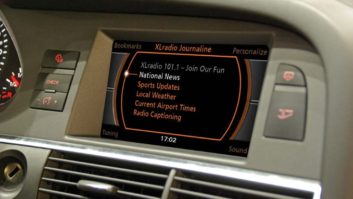
Portability in a very small package has finally arrived to the growing selection of HD Radio receivers. Amid a decent amount of pre-release advertising and promotion, the Insignia “Walkman-style” HD portable radio appeared nationwide in Best Buy stores in late July. I was lucky to snag one before all my local area stores sold out in a matter of weeks.
Antagonists of the controversial technology have always been quick to cite HD Radio’s inability to deliver receivers that perform well without lots of annoying dropouts. Or provide models that attract more than a yawn from consumers. The Insignia NS-HD01 is one HD Radio that should help put those criticisms to rest.
THE BEST BUY EXPERIENCE
I personally called and visited several stores around my market to check and see if the Insignia pocket HD was in stock, and if the salespeople knew anything about it. Whenever I’ve done this in the past, I’ve usually been met with blank stares or suggestions I must be looking for satellite radios. Not this time.
Best Buy appears to have shipped only limited quantities of Insignias to most of their stores nationwide. But at least some stores have made an effort at educating sales staffs about the radio and why it’s different than other Walkmans and satellite portables. At the first store I visited, the Insignia radio hanger, with a nice promotion placard and $49.99 price tag, was empty. The sales clerk checked stock and told me they had just sold the last one.
I engaged the 20-ish clerk to find out if she knew what HD Radio was and, to my pleasant surprise, she actually knew about the “secret stations between the stations.” She also knew about the Insignia component HD tuner, also being sold at Best Buy for $105. She offered to call a few nearby stores and found only two portables left, so I had them hold one I could pick up on the way home. Since then, many stores have already sold out of their second restocking. Your own Best Buy experiences may vary.
ISO BETTER PERFORMANCE
Anybody who has used HD Radio products knows what the shortcomings have been. Car radios generally perform well on the open road with the advantage of external antennas. Indoor desktop radios and tuners often need external antennas, especially in blocked and compromised venues. Supplemental channels suffer dropouts with no blend to analog. These problems are more pronounced in Class B and terrain-challenged areas of the country. We haven’t had a pocket HD Radio receiver with its earbud headphone wire antenna until now.
The usual method I’ve used to evaluate any kind of new model radio has been to see how well it holds up in various well-known reception areas of high multipath and HD dropouts. My own house is in one of those “black holes” where it’s very hard to get clean analog reception, let alone HD. Most desktops, especially early HD models, won’t hold most of the local market HD stations without a lot of futzing with their attached wire antennas. Using an outside antenna has been my only solution to get clean analog FM and consistent HD reception.
Walking around my house and yard, the Insignia portable performs surprisingly well. Yes, there are dropouts, but far fewer than I was expecting. What’s especially impressive is the initial blend from analog to HD lock. The analog signals are often noticeably contaminated with multipath noise, which totally disappears in HD.

Driving around and listening with the Insignia portable laying on the front seat and one earbud connected also yielded rather impressive results. Comparing the quality of simultaneous reception of the same stations with my after-market JVC HD car radio in the dash, I was quite surprised to find both radios performed very much the same. The brief dropouts encountered seemed to occur in the same locales. Overall, HD reception held up very well, even in areas blocked by hills and the densely packed tall downtown buildings.
Before installing HD in the car about four years ago, I was forced to put up with a lot of noisy multipath and stoplight fades during my daily commute. Since then, I’ve gotten so used to clean and dependable HD reception, I don’t even care to listen to analog any more. HD is simply that much better.
HD ACROSS THE COUNTRY
Selling HD Radio as a worthy successor to analog has been hampered by the widely varying perceptions of how well it performs across different markets. Every market, and the stations that serve it, has unique terrain features, different FCC-imposed transmitter power limits and different transmitter sites, with varying height and proximity to the population centers. These all affect the overall quality of reception.
There certainly are some markets more challenged than others where overall HD performance is poor in the suburban and fringe areas farther away from the primary FM transmitter sites. Most of the pro reviews I’ve read on HD Radios give their performance very little positive spiff. Many of those you find in trade journals and the Internet are written by folks living in New York City, Chicago, San Francisco and Los Angeles. Those are all Class B markets where most FMs operate with over-height antennas on tall towers or downtown skyscrapers. Except for the California super-power grandfathers, these stations run with reduced ERP. HD powers at 1 percent of analog run less than 70 watts in these markets. No wonder so many complain about frequent blending and HD2/HD3 dropouts.
A lot of these consumer reporters and reviewers need to get out a little more and discover how well HD Radio works in other areas. Out in Class C country, it’s often a different experience. But just don’t take my word for it. A decent sampling of consumer reviews of the Insignia portable as of this writing confirms that 34 out of 45 buying customers from all over the country give it high marks. Check them out at: tinyurl.com/y9eap5g
A few of the reviewers are disappointed the Insignia portable doesn’t include the AM band, an MP3 player or iTunes tagging. Others don’t like the rechargeable 10-hour battery life and non-replaceable battery. Some say there aren’t enough presets or the earbuds are uncomfortable. But for a breakthrough product of this size and impressive performance for under $50, I say it’s a slam-dunk winner. I have yet to find a radio fan interested in HD who doesn’t want it. Most have either bought one or are still trying to find stock at Best Buy. It’ll make a splendid Christmas present.
TURNING UP THE WICK
The single most daunting problem still dogging FM HD is the lack of reception stability. Any consumer who buys an HD radio and has trouble getting their favorite HD stations to stay locked will be disappointed and probably return it for a refund. We’ve known for a long time that more digital power is really the only viable solution.
The push for up to –10 dBc power increase has shifted into high gear. More stations that can increase HD power have requested and received STAs or experimental temporary licenses. I’ve had a chance to check in on a few; without exception, every engineer involved in the testing agrees that even a 3 dB increase is noticeable. A 6 dB boost provides very significant improvement and 10 dB is dramatic. Except for a few isolated first-adjacent interference complaints, most notably WRNI vs. WKLB in the Boston area, these increases have proven to be compatible with the existing analog service.
THE REAL VS. THE THEORETICAL
NPR Labs has done the most theoretical evaluation work characterizing the interference impact that an HD power increase would inflict over the entire FM band. With the help of the folks at FCCINFO.com, their quick calculator was devised as a measuring stick for determining what level of HD increase could be employed by any station without causing interference to their first adjacent neighbors. Check it out for your station at www.nprlabs.org/publications/distribution/interimIBOCpowerallowance/index.php.
The calculator projects the amount of OFDM sideband power (albeit very small) that occurs inside the first-adjacent channels of an HD station with a – 20 dBc injection, using this value as the limit allowed for an interfering contour for first-adjacent analog protection under the present rules. The amount of allowable HD power increase varies all the way from zero to the full 10 dBc, depending on the first-adjacent allocations situation for each station. It’s not too surprising the calculator yields rather conservative estimates for theoretically allowed increases. A number of Clear Channel, Greater Media and CBS stations that are running higher HD powers under STAs have demonstrated that the NPR calculator limits have been too restrictive when power increases are actually deployed and evaluated. My old friend and colleague, Clear Channel engineering exec Jeff Littlejohn, has recently gone on record confirming that conclusion, and is pressing harder for FCC adoption of HD power increases up to –10 dBc.
NPR Labs has also recently performed a number of field studies of existing stations and their first-adjacent neighbors involving experimental HD power increases. A summary report of the results and findings should be published this month. NPR Labs invited various “watchdog” observers from several commercial broadcast groups to participate in these tests and provide input.
The easiest way for the commission to correctly consider the HD power increase proposal and properly write it into law is to focus on the results of actual field tests. Temporary power increases for such testing should be encouraged and quickly granted when requested so that more stations can collect and report more field data. Theoretical expectations lose their importance when they can be replaced by real world measurements. Let’s just hope this process doesn’t take too long.
Guy Wire is the pseudonym for a veteran radio broadcast engineer.









